Railway freight transport statistics
Data extracted in October 2023.
Planned article update: 30 October 2024.
Highlights
Rail freight transport for main undertakings, EU, 2012-2022
This article presents the main trends in rail freight transport statistics in the European Union (EU), and the EFTA countries Norway and Switzerland as well as the candidate countries Montenegro, North Macedonia and Türkiye. It covers quarterly and annual data for total transport and annual data for national, international and transit transport. Railway transport by type of goods is also presented.
This article, together with the article Railway passenger transport statistics - quarterly and annual data, presents a complete overview of railway transport in Europe.
Full article
EU rail freight transport performance slightly decreased in 2022 compared with the previous year
The evolution of the EU rail freight transport performance between 2012 and 2022 is presented in Figure 1. It has to be noted that the data from Belgium are not included due to confidentiality. From 2012 to 2016, the level of rail freight transport was rather stable (varying between -0.9 % and +1.7 % ), then rose in 2017 and 2018 (+3.1 % and +3.0 %, respectively), reaching a peak at 400 billion tonne-kilometres (tkm). In 2019, rail freight transport performance fell moderately by 2.2 % and significantly dropped further in 2020 by 6.1 % compared with the previous year. To prevent the spread of the COVID-19 pandemic, countries took restrictive measures starting in March 2020. These restrictions had a significant impact on rail freight transport, albeit at a lower level than for rail passenger transport. In 2021, a recovery can be observed with an 8.7 % increase compared with 2020, reaching almost the high level of 2018, at 399 billion tkm. This upward move did however not continue in 2022 as rail freight transport performance, with 398 billion tkm, slightly decreased compared with 2021 (-0.5 %).
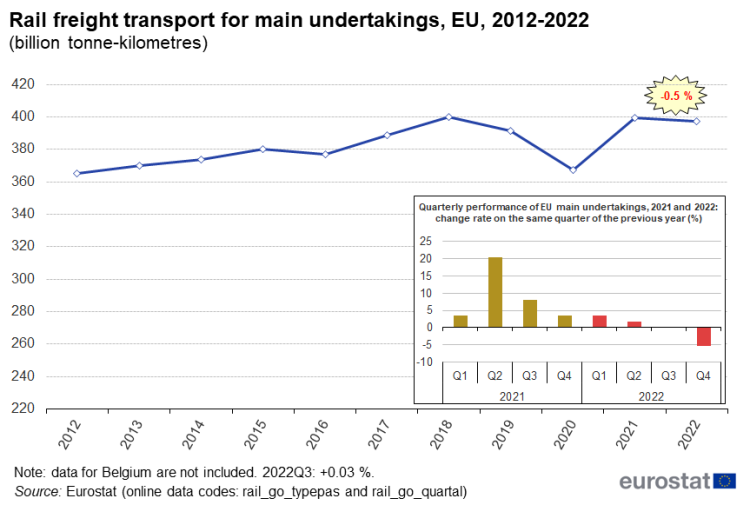
(billion tonne-kilometres)
Source: Eurostat (rail_go_typepas) and (rail_go_quartal)
When looking at the quarterly rail performance at EU-level, a recovery was observed in all quarters of 2021. The highest growth rate in rail freight transport performance was recorded in the second quarter of 2021 (+20.5 %), followed by the third quarter (+8.0 %). In the first two quarters of 2022, the performance further increased by 3.6 % and 1.9 %, respectively, compared with the same quarters of 2021. While the third quarter of 2022 remained rather consistent compared with 2021, a decline by 5.4 % was recorded in the fourth quarter of 2022.
Germany recorded the highest rail freight transport performance in the EU
Germany was by far the largest contributor to the rail freight transport performance in the EU, with 125 billion tkm in 2022, representing around 31 % of the EU total (see Figure 2). Poland and France followed with 59 and 35 billion tkm, respectively. At the other end of the scale, Greece, Luxembourg and Ireland registered less than 1 billion tkm in 2022. The two candidate countries Montenegro and North Macedonia reported less than half a billion tonne-kilometres in 2022.
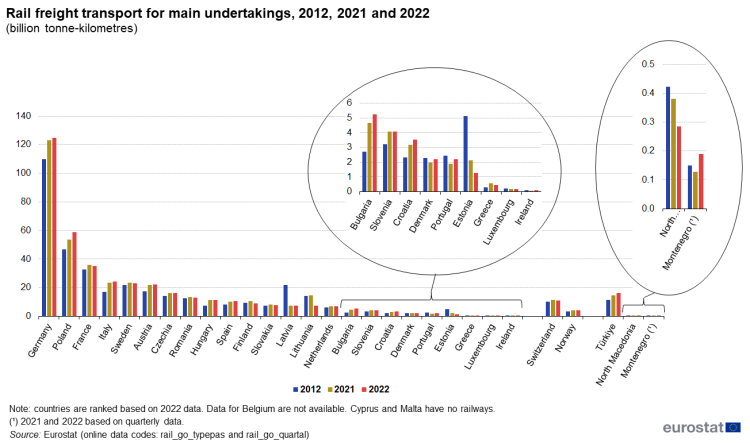
(billion tonne-kilometres)
Source: Eurostat (rail_go_typepas) and (rail_go_quartal)
In 10 EU Member States, rail freight transport recorded a decrease between 2021 and 2022. The largest drops were observed in Lithuania (-49.4 %) and Estonia (-39.5 %) and can be mainly attributed to the restrictions in freight transport with Russia due to its war aggression in Ukraine. A substantial fall over the same period can also be observed in Greece and Finland (-20.9 % and -17.7 % respectively) and as well in the candidate country North Macedonia (-24.9 %). By contrast, rather high increases between 2021 and 2022 were observed in Portugal (+16.4 %), followed by Ireland (+15.9 %), Bulgaria (+12.3 %), Denmark (+11.3 %), Croatia (+11.2 %) and Poland (+10.1 %). The candidate country Türkiye also increased substantially by 10.0 %. In absolute terms, Poland was by far the country with the highest increase, with a 5.4 billion tkm increase between 2021 and 2022. Germany followed with a growth of 1.5 billion tkm over the same period. By contrast, Lithuania was by far the country with the highest fall (-7.2 billion tkm) between 2021 and 2022, followed by Finland (-1.9 billion tkm) over the same period.
Rail freight transport performance by type of transport (national, international loadings, international unloadings and transit) in total tkm performed is shown in Figure 3. For the EU as a whole, the share of national transport in 2022 can be estimated at 50.2 %, international unloadings at 19.8 %, international loadings 17.7 % and transit freight transport at 12.3 %. In this context, transit transport performance for the EU is calculated as the sum of the transit transport performance reported by each EU Member State.
The share of international transport in total rail freight transport in the various countries is strongly linked to their geographical position within Europe. The countries which registered the highest shares of international transport are located in the key corridors within the European market. Greece registered the highest share of international transport on total transport performance in 2022, with 99.0 %. In Latvia, which is located at the border between the EU and Russia, international transport accounted for 87.1 % in total tkm performed in 2022, mainly consisting of unloadings (71.7 %). The Netherlands, strategically situated in the heart of the European market, registered a share of international transport of 83.6 % in total tkm performed, mainly loadings for rail carriage (62.3 %). The key import port of Rotterdam, with large sea/rail transfers of goods dispatched within the EU, strongly influences these figures. Luxembourg also registered a high share of international transport with 82.0 %.
By contrast, countries with specific geographical characteristics (at the periphery of the European Union or islands) recorded a lower share of international freight transport by rail. No international transport has been reported by Ireland for 2022 and relatively small shares were observed for Denmark (14.3 %), Spain (15.6 %) and Finland (16.7 %). For these countries, the preferred mode for international freight transport remains maritime transport where goods are delivered at the nearest port and then further transported to the final destination country mainly by road and at a smaller rate also by rail (accounted as national transport). Türkiye also recorded a low percentage (11.9 %) of international freight transport which may also be linked to its peripheral position.

(%, based on tonne-kilometres)
Source: Eurostat (rail_go_typepas)
Regarding transit transport in the EU, Denmark registered the highest share in 2022, with 80.7 %, followed by Hungary (39.3 %), Austria (37.4 %), Slovakia (35.2 %) and Croatia (31.6 %). Similar high shares were also recorded in 2022 in Switzerland (67.3 %) and North Macedonia (67.6 %). By contrast, six EU Member States (Estonia, Ireland, Spain, Italy, Portugal and Finland) and the EFTA country Norway did not report any transit rail freight transport in 2022, while Greece reported less than 0.1 %.
When looking at national rail transport, the highest shares in 2022 were observed in Ireland (100 %), Spain (84.4 %), Finland (83.3 %), Portugal (73.1 %), Romania (71.0 %), Poland (70.8 %), Sweden (61.7 %) and France (59.4 %). National transport was also dominant in Türkiye (87.5 %), Norway (67.8 %) and Montenegro (62.2 %). On the other side of the scale, national transport represented only 1.0 % in Greece, 5.0 % in Denmark, 5.2 % in Latvia and 7.7 % in the Netherlands.
More than half of the EU Member States recorded a decrease in rail freight transport tonnage between 2021 and 2022
Rail freight transport expressed in tonnes is presented in Figure 4. The picture is slightly diverse when analysing the evolution from 2021 to 2022. Out of the 25 EU Member States which have rail transport, 14 recorded a decrease in 2022 compared with 2021. Lithuania registered the highest fall (-39.4 %), followed by Estonia (-24.0 %), Finland (-22.3 %) and Greece (-19.8 %). North Macedonia and Norway also recorded a substantial decrease over the same period (-27.7 % and -10.8 %, respectively). In absolute terms, Lithuania was again the country with the highest decrease, with a fall of 20 million tonnes between 2021 and 2022. Finland and Czechia followed with a decrease of 9 million tonnes each, over the same period.
The highest increase in tonnage compared with 2021 was observed in Denmark (+11.9 %), followed by Croatia (+7.1 %) and Bulgaria (+6.1 %). The Netherlands registered an increase between 2021 and 2022 in terms of tonnes transported while they recorded a fall in terms of tonne-kilometres, which is reflecting a reduction in the distances covered in this country. By contrast, Austria, Czechia, Latvia and Portugal recorded a decrease between 2021 and 2022 in terms of tonnes carried while they recorded a slight growth in terms of tonne-kilometres.
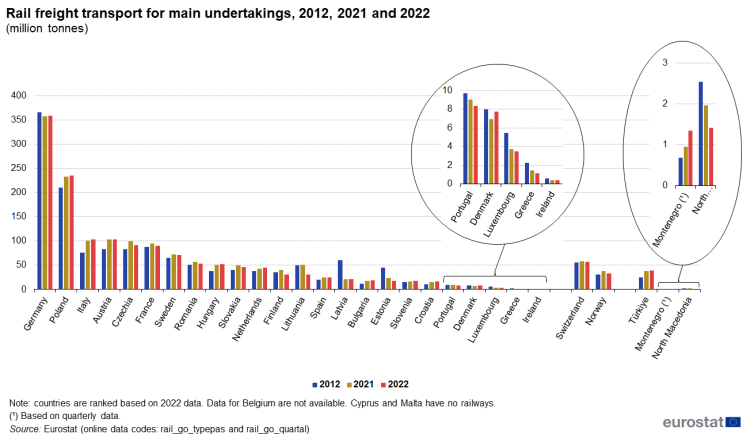
(million tonnes)
Source: Eurostat (rail_go_typepas) and (rail_go_quartal)
Figure 5 presents the tonnes of rail freight transported in relation to the population of the reporting country. Estonia had the highest rate in 2022, with 13.1 tonnes per capita, followed by Austria (11.4), Latvia (11.3) and Lithuania (10.9). Eight EU Member States transported between 5 and 9 tonnes per capita, eight others between 1 and 5 tonnes per capita, and four less than 1 tonne per capita. Greece and Ireland registered the lowest rate with 0.1 tonne per capita in 2022. Also, Türkiye recorded less than 1 tonne per capita in 2022.
When comparing with 2021, Lithuania and Estonia registered the largest decline in tonnage per capita in 2022, with -7.3 and -4.4 tonnes per capita, respectively. When looking at the evolution over a 10-year period, a gradual decrease can be observed for Estonia (-20.7 tonnes per capita), for Latvia (-18.5 tonnes per capita) and for Luxembourg (-4.9 tonnes per capita) in 2022 compared with 2012.
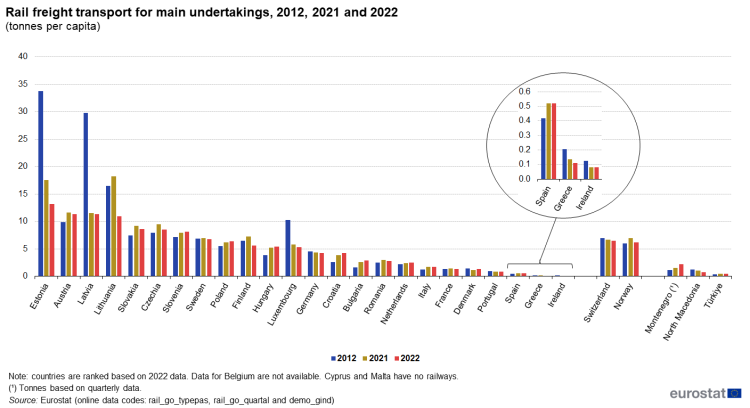
(tonnes per capita)
Source: Eurostat (rail_go_typepas) and (rail_go_quartal)
The largest goods category transported by rail in 2022 was 'metal ores and other mining and quarrying products; peat; uranium and thorium'
Figure 6 presents the share of the different types of goods (according to the NST2007 classification) transported by rail, expressed in tonne-kilometres and tonnes. It shall be noted however, that the high share of unidentifiable goods reported has an impact on the overall results presented.
At EU level, the main types of goods transported in 2022, based on tkm, were 'metal ores and other mining and quarrying products; peat; uranium and thorium' (NST2007 division '03') (11.7 %), 'coke and refined petroleum products' (NST2007 division '07') (10.0 %), 'coal and lignite; crude petroleum and natural gas' (NST2007 division '02') (9.0 %), 'basic metals; fabricated metal products, except machinery and equipment' (NST2007 division '10') (8.1 %), 'products of agriculture, hunting, and forestry; fish and other fishing products' (NST2007 division '01') (6.7 %) and 'chemicals, chemical products, and man-made fibers; rubber and plastic products; nuclear fuel' (NST2007 division '08') (6.3 %).
In terms of weight (in tonnes), the main type of goods transported was also 'metal ores and other mining and quarrying products; peat; uranium and thorium', but with a higher share (13.8 %) than in terms of tkm. The second main share in total weight of products carried was of the category 'coal and lignite; crude petroleum and natural gas' (13.0 %), which was in third position in terms of tkm. 'Coke and refined petroleum products' came third, with a share of 9.9 %. The fourth type of goods carried was 'basic metals; fabricated metal products, except machinery and equipment' (9.0 %) with similar ranking as per tkm. 'Products of agriculture, hunting, and forestry; fish and other fishing products' and 'chemicals, chemical products, and man-made fibers; rubber and plastic products; nuclear fuel' were in the fifth and sixth position with 6.7 % and 6.0 %, respectively.
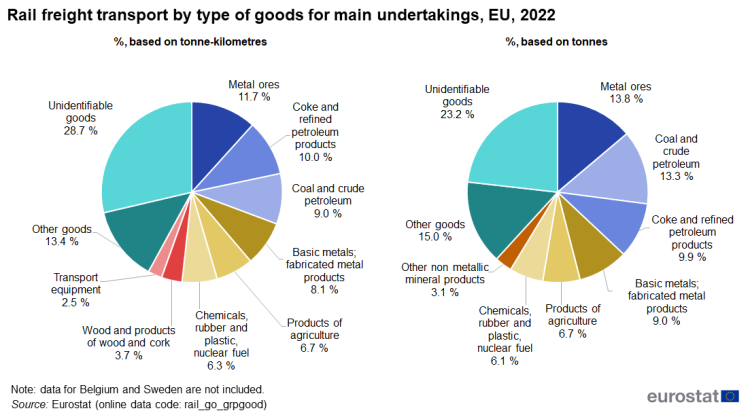
Source: Eurostat (rail_go_grpgood)
Source data for tables and graphs
Data sources
The figures presented in this article have been extracted from the Eurostat rail transport database. They include data on national, international and transit transport of the Member States, EFTA and Candidate countries, collected according to the Regulation (EU) No 2018/643 recast of Regulation (EU) No 2016/2032. There are no railways in Cyprus, Malta and Iceland. The various elements present data collected under the detailed reporting system, meaning that data include only main undertakings which are defined as follows:
- Until 2015: undertakings with a total transport performance greater than 500 million tonne-km or 200 million passenger-km.
- From 2016: undertakings with a total volume of goods transport of at least 200 million tonne-km or at least 500 000 tonnes or a total volume of passenger transport of at least 100 million passenger-km.
Railway undertakings which are below these thresholds may however be included for some countries. Basic results and derived indicators (such as growth rates and shares in percentage of total) in the tables are rounded. However, the figures are based on the non-rounded original data. As a result, the sum of shares in percentage of total, as shown in the tables, is not necessarily equal to 100 %. Explanatory notes for countries are available in the metadata on the Eurostat website. Symbols
| : | not available |
| - | not applicable |
| 0 | actual zero or very negligible transport |
| c | confidential data |
Context
The content of this statistical article is based on data collected within the framework of Regulation (EU) No 2018/643 recast of Regulation (EU) No 2016/2032.
Direct access to
- Transport, see:
- Railway transport (t_rail)
- Goods transport by rail (ttr00006)
- Transport, see:
- Railway transport (rail)
- Railway transport measurement - Goods (rail_go)
- Historical data (1982-2002) (rail_go_h)